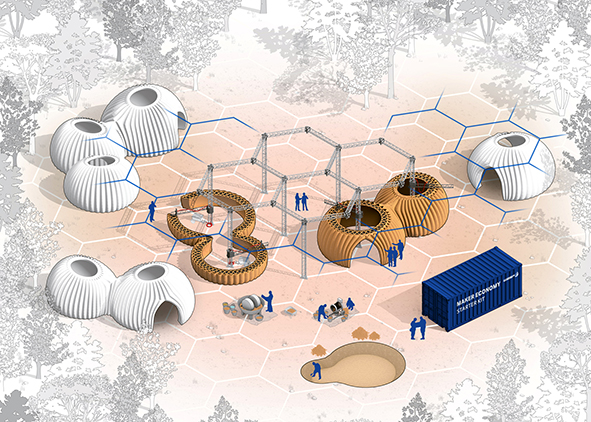Shamballa, Heaven can wait. How 3D printing will sustain the future
DOI:
https://doi.org/10.19229/2464-9309/832020Keywords:
digital manufacture, ethics, innovation, social design, sustainabilityAbstract
This article is devoted to the activities of the WASP group of which Massimo Moretti is the founder, and emphasizes how it is possible to reconcile technological progress with the creation of a heaven on earth: a society of equals, eco-compatible, scientifically evolved and completely open-source. This is not utopia. It is actually taking place thanks to projects that respond in concrete fashion to the basic needs of Man: food, home, health, energy, work and culture. The case of WASP is a pointer to changes that are occurring. An accumulation of futuristic technology geared towards a social application. It is also a clear demonstration of how an ethical vision is actually practicable within the logic of the business community. Moreover, it is the demonstration of how an ethical vision may become the driving force in developing projects and technologically advanced machines, which are then sold to feed the dream: to build heaven on earth.
Downloads
Article Metrics Graph
References
Anderson, C. (2012), Makers – The New Industrial Revolution, Crown Business, New York.
Beccarisi, A. (2015), Eckhart, Carocci, Roma.
Berzin, A. (n.d.), “The Nazi Connection with Shambhala and Tibet”, in Study Buddhism. [Online] Available at: studybuddhism.com/en/advanced-studies/history-culture/shambhala/the-nazi-connection-with-shambhala-and-tibet [Accessed 15 November 2020].
Candiani, C. (2004), “Dhannapada (I versi della legge)”, in Filippani-Ronconi, P., Il buddhismo – Storia e dottrina, Newton & Compton, Roma, pp. 121-178.
Falcinelli, R. (2014), Critica portatile al visual design – Da Gutenberg ai social network, Einaudi, Torino.
Fezia, L. (2013), Misteri, crimini e storie insolite di Torino – Gli enigmi insoluti, i misteri oscuri e i delitti irrisolti della capitale italiana dell’esoterismo, eBook, Newton Compton editori, Roma.
Filippani-Ronconi, P. (ed.) (2004), Canone Buddhista. Discorsi brevi, eBook, UTET, Torino.
Francescoji, M. (2013), Tre anni a Shamballah con Babaji il Cristos indiano, BookSprint, Romagnano del Monte (SA).
Heskett, J. (1990), Industrial Design, Rusconi, Milano.
Loos, A. (1972), “Ornamento e delitto”, in Loos, A., Parole nel vuoto, Adelphi, Milano, pp. 217-229.
Maldonado, T. (2019), “È attuale il Bauhaus?/2”, in Maldonado, T., Bauhaus, Feltrinelli, Milano, pp. 97-108.
Manzini, E. (2015), Design, When Everybody Designs – An Introduction to Design for Social Innovation, The MIT Press, Cambridge (MA).
Meneguzzo, M. (1993), Bruno Munari, Laterza, Roma-Bari.
Meyer, H. (1972), “Costruire”, in Wingler, H. M., Il Bauhaus – Weimar Dessau Berlino 1919-1933, Feltrinelli, Milano, pp. 259-260.
Moretti, F. (2016), “Torna la BigDelta12m di WASP”, in 3dwasp, 23/03/2016. [Online] Available at: www.3Dwasp.com/torna-la-bigdelta-di-wasp/ [Accessed 14 November 2020].
Papanek, V. (1970), Design for the Real World – Human Ecology and Social Change, Bantam Books, Toronto-New York-London.
Pasca, V. (2018), “Dopo i discorsi sulla fine”, in Eco, U. and Gregotti, V., Sulla fine del design, Lotus, Milano, pp. 33-39.
Radjou, N., Prabhu, J. and Ahuja, S. (2012), Jugaad Innovation – Think Frugal, Be Flexible, Generate Breakthrough Growth, Jossey-Bass, San Francisco (CA).
Ramacharaka, Y. (2010), Bhagavad Gita, Cosimo, New York.
Revedin, J. (2020), La Signora Bauhaus, Neri Pozza, Vicenza.
Riccini, R. (2019), “Bauhaus: insegnamento e politica”, in Maldonado, T., Bauhaus, Feltrinelli, Milano, pp. 111-120.
Russo, D. (2015), “La stampa 3D come Iperartigianato. Utopia tecno | eco | logica per la configurazione di un mondo migliore”, in MDA (ed.), Environmental Design – 1st International Conference on Environmental Design, De Lettera, Milano, pp. 95-106.
Schivarelli, N. (2018), “WASP Hortus Sistema di Coltivazione Verticale Idroponica”, in 3dwasp.com, 03/10/2018. [Online] Available at: www.3Dwasp.com/wasp-hortus-sistema-di-coltivazione-verticale-idroponica/ [Accessed 15 November 2020].
Simon, H. A. (2019), The Sciences of the Artificial, MIT Press, Cambridge (MA).
Speare-Cole, R. and Mitevska, T. (2018), “Europe’s 100 digital champions”, in Financial Time, 21/11/2018. [Online] Available at: www.ft.com/content/6d68a236-e153-11e8-8e70-5e22a430c1ad [Accessed 15 November 2020].
Sposito, C. and Scalisi, F. (2017), “Strumenti e materiali per la fabbricazione digitale in architettura | Instruments and materials for digital manufacturing in architecture”, in Agathón | International Journal of Architecture, Art and Design, vol. 1, pp. 143-151. [Online] Available at: doi.org/10.19229/2464-9309/1222017 [Accessed 15 November 2020].
Taleb, N. N. (2012), Antifragile – Things That Gain from Disorder, Random House, New York.
Teghini, T. (2019), “WASP stampa in 3D cibo e plastica riciclata per favorire l’economia circolare”, in 3dwasp, 03/12/2019. [Online] Available at: www.3Dwasp.com/wasp-stampa-in-3D-cibo-e-plastica-riciclata-per-favorire-leconomia-circolare/ [Accessed 15 November 2020].
UN – General Assembly (2015), Transforming Our World – The 2030 Agenda for Sustainable Development, document A/RES/70/1. [Online] Available at: www.un.org/ga/search/view_doc.asp?symbol=A/RES/70/1&Lang=E [Accessed 14 September 2020].
Vercelloni, M. and Bianchi, R. (2004), Design, Mondadori, Milano.

Downloads
Published
How to Cite
Issue
Section
License
This Journal is published under Creative Commons Attribution Licence 4.0 (CC-BY).
License scheme | Legal code
This License allows anyone to:
Share: copy and redistribute the material in any medium or format.
Adapt: remix, transform, and build upon the material for any purpose, even commercially.
Under the following terms
Attribution: Users must give appropriate credit, provide a link to the license, and indicate if changes were made; users may do so in any reasonable manner, but not in any way that suggests the licensor endorses them or their use.
No additional restrictions: Users may not apply legal terms or technological measures that legally restrict others from doing anything the license permits.
Notices
Users do not have to comply with the license for elements of the material in the public domain or where your use is permitted by an applicable exception or limitation.
No warranties are given. The license may not give users all of the permissions necessary for their intended use. For example, other rights such as publicity, privacy, or moral rights may limit how you use the material.


















































































